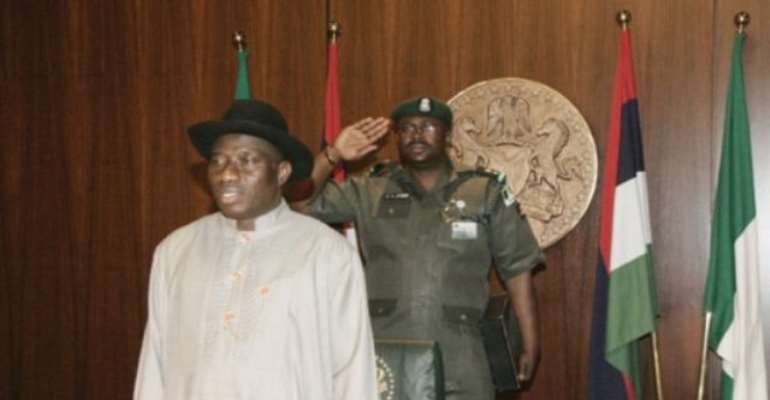MR. PRESIDENT, WHAT ABOUT A MORE DIVERSE ATTIRE, CULTURALLY

In a highly culturally sensitive and multicultural society like Nigeria, where the manner and style of dressing deeply reflect various ethnic backgrounds, the wearing of a one-way-style clothing by the president, day in and day out, appears to illustrates ethnic narrowness. This is not necessarily an unspeakable trend as it vividly portrays one's ethnic pride. In this case, his own.
Of course, Jonathan has put on non-Ijaw attires periodically, but it is strictly on the basis of regional and special occurrences as recently observed in Kastina, in Church and Oyo.  It is a welcomed observation; however, let the presidential dress be a matter of freewill, evenness and on the stand of frequency.
Nigeria by definition, at least, politically, appears to stand out as a Presidential Democracy, but if truth be told the country is rooted, ingrained and engulfed in what could be called a Tribal Democracy.
As a matter of fact, every aspect of action, arrangement or display is zoned along the lines and dictates of tribal attitude, and locked in step with the spirit of tribal democracy. President Jonathan therein lies the dilemma.
President Jonathan ought to know that this ethnic based reality, a peculiar reality for that matter, makes Nigeria a continuously multifaceted society.
It is true that as an individual, one has the basic right to wear what pleases him or her as long the dressing is socially appropriate, and the manner of clothing is beyond open or revealing nakedness.
Historically, past civilian Heads of States, Prime Ministers or Presidents, irrespective of their ethnic background, in Nigeria specially, mainly wore a more authority, power, and commanding-placed attire like the Agbada, a grand looking, over flowing outfit usually worn with a strikingly and positioned oval looking hat.
The Agbada is glamorous in representation, and it is usually a well designed outfit which is generally viewed, nationally, and internationally, as the direct equivalent to a formal three or two-piece suit and a tie, the often worn official attire by an American, European or other 'Oyibo'-based President.
As to President Jonathan, he is known to frequently put on a traditional two-piece suit, popularly known as the 'Woko', which is usually topped with a wide or broad brim/bowler dark hat—a European style sun looking hat favored by his kinfolks, the Ijaws of the Niger Delta.
Certainly, this mode of presidential attire is a great art and a marked welcome, especially when the President is gradually popularizing this dressing style within the circle of the powers- that- be, and also along the lines of the popular three piece outfits like the Agbada and Babaringa.
But there is something about this whole clothing mood.
Jonathan unlike his predecessors could now and then, include in his clothing style other Nigerian diverse wears such as: the Buba and Sokoto, Kaftan, Kaba, Danshiki, Agbada, and Babaringa. There is also the Wrapper, which is usually hand woven and topped with a wide shirt.
In addition, there is the availability of various styles of a big long sleeve shirt usually topped over a long piece of a wrap tied around the waist, with beads visibly worn around the neck.
There are so many elegant and dignified, looking formal and casual brands of traditional clothing commonplace in Nigeria.
In our current global and interdependent world, Jonathan could occasionally put on a Euro-American style three or two piece suit with his known hat of choice, the bowler or broad looking brim hat as long as it is not overly masking his face. And in ordinary situations, he could wear a simple shirt and trouser, even in jeans form.
These examples of assorted clothing are cultural markers of a society like Nigeria with different ethnic, social and cultural groups, for example: the   Hausas, Fulanis, Kanuris, Tivs, Yorubas, Rivers, Igbos, Edos, Esans, Urhobos, Itsekiris, Afemais, Oras, Idomas, Igbirras, Okrikas, Isokos, Akwa Iboms and others.
Also in the midst of all these diverse groups are the 21st century Nigerian youths and the Euro-American or 'Oyibo'-settled Nigerians.
Every one of these groupings wants to be represented in the display of the presidential attire, and for a reason much clearer to the president than anyone else—ethnic pride.
If the President was to put to practice these ethno-cultural expressions and ideas, each of these groups which are equally known for their culturally sensitive and territorial charged backgrounds, could begin to see a part of their way of dressing or clothing style in the President. A good thing, at best.
In this regard, Jonathan could turn out to be the first leader whose presidential attire not only represents diverse groups but also opened the way to bring in cultural pride to all or most ethnic groups including his own, the Ijaws.
By this way, the President, for the first time in the nation's history will be adding a new way to foster national unity. God knows we need it.
John Egbeazien Oshodi, Ph.D, DABPS, FACFE, is a practicing Clinical/Forensic Psychologist and the Interim Associate Dean of Behavioral Science, Broward College, Coconut Creek, Florida. [email protected]
 
